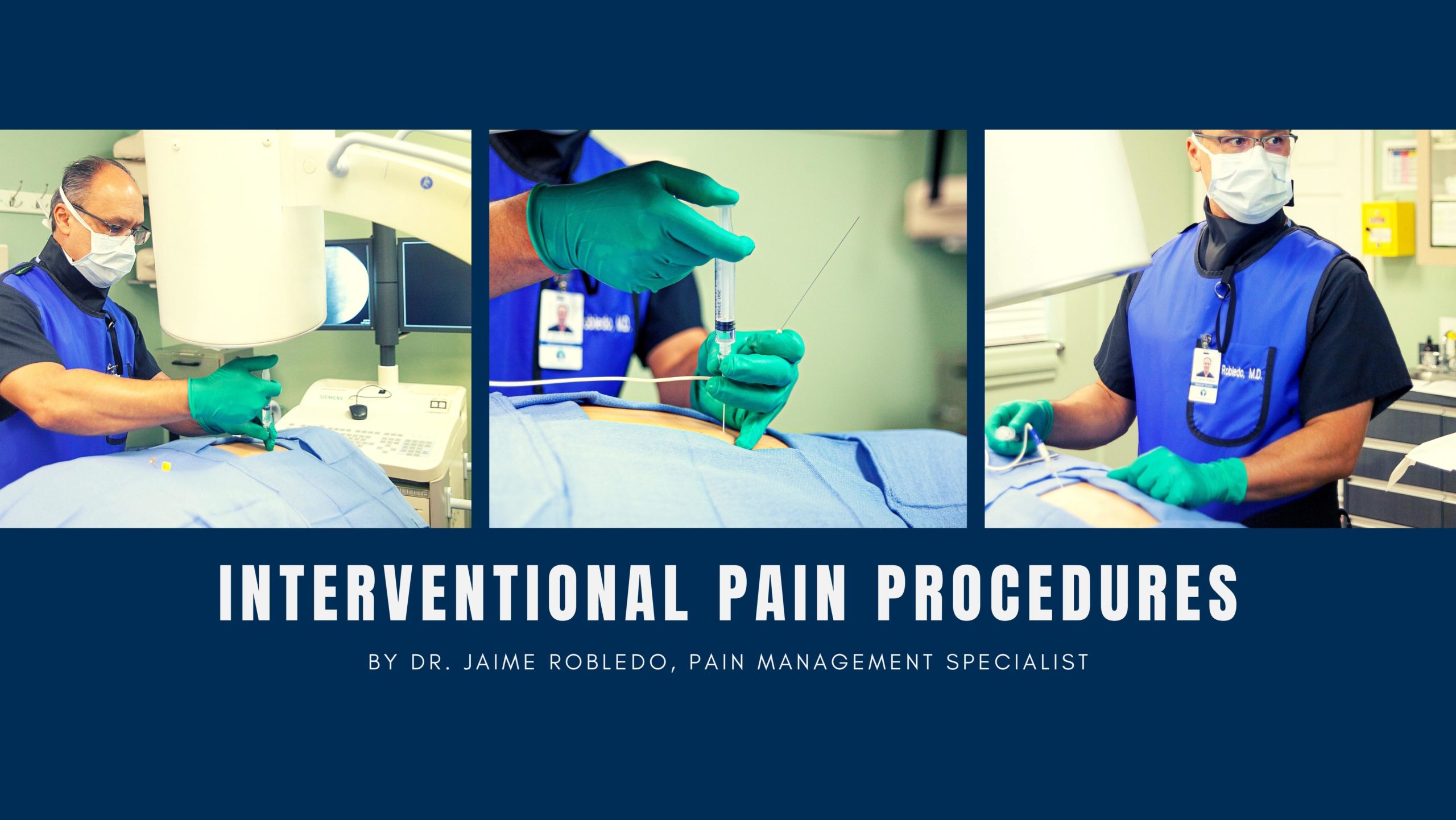Advanced Interventional Pain Consultants offers interventional office pain management procedures and are performed by Dr. Jaime Robledo. The treatments are safe, minimally invasive, and clinically proven to be highly effective.

Services
Advanced Interventional Pain Consultants offer Interventional Procedures performed by Dr. Jaime Robledo. The treatments are safe, minimally invasive, and clinically proven to be highly effective.
A transforaminal injection is an injection of long-acting steroid into the opening at the side of the spine where a nerve roots exit.
The long-acting steroid that is injected reduces the inflammation and swelling of spinal nerve roots and other tissues surrounding the spinal nerve root. This may reduce pain, tingling and numbness, and other symptoms caused by such inflammation, irritation, or swelling.
Also, the transforaminal injections can be used to identify a specific spinal nerve root level or levels that are the source of pain. The transforaminal injection consists of a mixture of saline, local anesthetic, and long-acting steroid medication.
This procedure is done under local anesthesia.
The actual injection takes five to ten minutes.
An epidural injection is an injection of long-lasting steroids and occasionally some other medications into the epidural space. The epidural space is the area that surrounds the spinal cord and the nerves coming out of it.
Epidural injections are quite successful for spinal stenosis or a gradually tightening of the spinal canal from degenerative processes. Epidural injections can also help degenerative disc disease, certain neuropathies, reflex sympathetic dystrophy, and other conditions.
Immediately after the injection, you should feel much the same as before the injection. You may have a small numb area at the injection site. You may also have some deep aches from the passing of the injection needle. Certain patients, especially those with prior neck or back surgery around the injection site, may have some soreness or ache for a day or two. This is due to the mechanical process of needle insertion and initial irritation from the volume of the medications injected. You should start noticing pain relief starting the third day or so.
This procedure is done under local anesthesia.
The actual injection takes five to ten minutes.
Facet injections are injections of medications into the actual facet joints. Facet injections are used to reduce the inflammation and swelling of tissue in and around the facet joint space. This may reduce pain and other symptoms caused by inflammation or irritation of the facet joint and surrounding structures.
Patients with arthritic or thickened facet joints on X-rays that also have any chronic back or neck pain with movement are usually good candidates for facet injections.
Most patients receiving facet injections have already tried other, more conservative treatments, including anti-inflammatory medication, chiropractic, or physical therapy.
The injection consists of a mixture of local anesthetic and a steroid medication.
The actual injections take only about 10 to 20 minutes.
A sacroiliac (SI) joint injection – also called a sacroiliac joint block – is primarily used either to diagnose or treat low back pain and/or sciatica symptoms associated with sacroiliac joint dysfunction.
The sacroiliac joints lie next to the spine and connect the sacrum with the hip on both sides. There are two sacroiliac joints, one on the right and one on the left. Joint inflammation and/or dysfunction in this area can cause pain.
The purpose of a sacroiliac joint injection is two-fold: to diagnose the source of a patient’s pain and to provide therapeutic pain relief. At times, these are separated and a patient will undergo a purely diagnostic or therapeutic injection, although often the two are combined into one injection.
Radiofrequency nerve (RFN) ablation is a treatment that uses radiofrequency energy to heat and destroy nerves to reduce pain. When a nerve is heated in this way, it can no longer send pain signals. RFN ablation is commonly used to treat pain arising from facet joints. Tiny nerves, called medial branch nerves, supply facet joints and transmit pain. RFN ablation destroys these nerves and lessens pain.
Like facet joint injections or MBB, RFN is done with x-ray guidance. Intravenous medicines and local anesthetics are used to decrease the pain of the treatment and keep you as comfortable as possible. Specially-designed insulated needles are placed near or on the facet joint nerves. The RFN needle has a special tip that is not insulated and heats up. Once the needle is in place, the area is numbed, and the needle is attached to the RFN machine. The heat produced at the needle tip destroys the nerve’s ability to transmit pain.
A spinal cord stimulator is a device used to exert pulsed electrical signals to the spinal cord to control chronic pain.
In the simplest form, spinal cord stimulation (SCS) consists of stimulating electrodes implanted in the epidural space, an electrical pulse generator implanted in the lower abdominal area or gluteal region, conducting wires connecting the electrodes to the generator, and the generator remote control. SCS has notable analgesic properties and, at present, is used mostly in the treatment of failed back surgery syndrome, complex regional pain syndrome, and refractory pain due to ischemia.
SCS is analgesia on demand. It is a useful option when other forms of therapy fail. It reduces pain medication and side effects. It is effective in about 50–70% of cases. It is an invasive procedure, which can have associated complications such as infection, bleeding, and dural puncture. It has the risk of disconnection or equipment failure.
Other procedures
- Cervical, Thoracic, Lumbar, and Sacral Medial Branch
- Joint Injections: shoulder, hip, knee, wrist, elbow, ankle
- Trigger Point Injections
- Minimal Invasive Lumbar Decompression
- Intradiscal Allograph Injections
- Sacroiliac Lumbar Stabilization
- Posterior Lumbar Stabilization
- Basivertebra Nerve Ablation
- PRP and BMAC
- Ketamine Infusion Therapy
